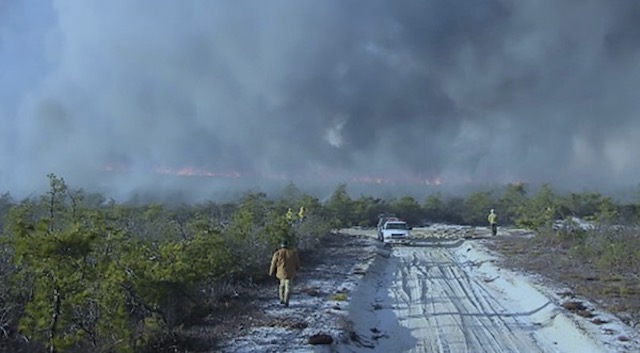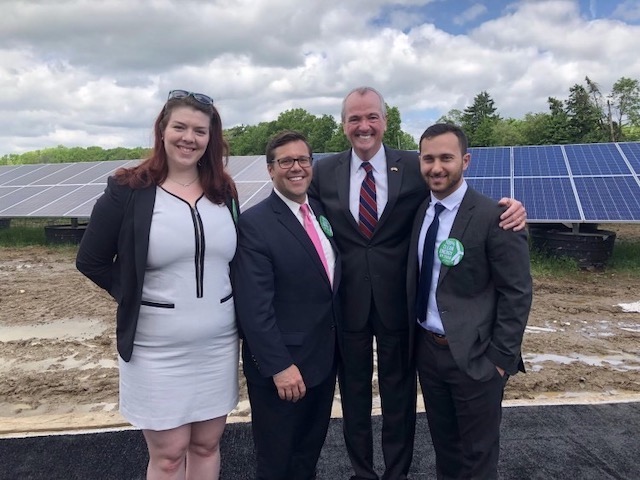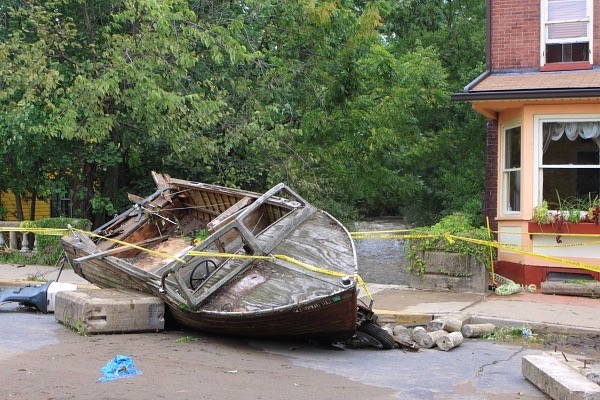Pinelands Endocrine Disruptor Study Is A Whitewash (Part 1)
Study Obscures Role Of Corporate Polluters And Big Pharma
Wm. Penn Foundation funded study produces junk science
The Pinelands Commission finally released a long delayed study on the ecological impacts of endocrine disrupting chemicals, see:
I wrote about the delay in releasing that study last year and had recently filed an OPRA public records request to the Pinelands Commission for the data and to determine the status of the report, as well as to highlight the implications of this research, see:
- Sexual mutations in fish in protected waters raise alarm (Bergen Record story on USGS Report)
Given the complex scientific, regulatory, and ethical issues, we will present this story in two parts: Part One below examines the funding of the study and the influence of the Wm. Penn Foundation.
Part Two tomorrow will critique the design, methodology, findings, and conclusions of the study.
I) Who Is The Wm. Penn Foundation And Who Do They Represent?
The study was funded by the Wm. Penn Foundation. The Foundation has allocated over $100 million to various projects in the Delaware River Watershed, including the Pinelands and non-profit groups that do advocacy work in the Pinelands, own land and operate commercial concessions in the Pinelands, and appear before the Pinelands Commission, including the Pinelands Preservation Alliance, NJ Audubon Society, and NJ Conservation Foundation.
By their own statements, the Wm. Penn Foundation’s Delaware initiative was designed as a parallel program to Clean Water Act based government planning and regulatory programs. They fund projects that work only on voluntary programs to address non-point source pollution.
They do not work on point source pollution or government planning and regulatory programs that regulate corporations or industrial chemical discharges.
They promote non-regulatory, voluntary, local, and market based initiatives: (Delaware River watershed)
The DRWI was designed and launched in the absence of any state or federally mandated watershed-wide requirement for restoration or protection of water quality. It is an NGO-led watershed protection program driven by the cumulative effort, strategic thinking, and vision of over 50 organizations…
And they openly acknowledge the top down Foundation money driven astro-turf nature of that initiative and its limited focus to non-point pollution (intentionally letting regulators and major corporate “point source” polluters off the hook) Delaware River watershed:
While the DRWI was conceived and designed in partnership with others as a William Penn Foundation grantmaking strategy, our hope is that, through the process of building and refining the Initiative with the input of dozens of participants and stakeholders, there is a framework of relationships and practice that will endure beyond our grantmaking that can methodically address nonpoint source pollution over time.
This narrow focus of Wm. Penn Foundation limits and distorts the advocacy work of the environmental and conservation groups they fund and misleads the public.
Wm. Penn Foundation has over $3.2 billion in assets and $175 million in revenue (2020). Senior managers are paid over $280,000/yr.
But before we get to the science and findings of the study, let’s start here and see who the Wm. Penn Foundation is and who they represent:
The Haas story begins, unsurprisingly, with an exceptional couple. Otto Haas came to Philadelphia from Germany in 1909 to begin expansion of his company, Rohm and Haas. The company, which started as a maker of leather tanning materials, grew to become a massive specialty chemical manufacturer, and Otto found success beyond his wildest dreams. In 1945 he used some of his wealth to start a foundation to address post-war social issues, particularly focused on helping fatherless children. This foundation eventually became the William Penn Foundation, a Philadelphia-centric institution that works on all manner of important causes, including education, conservation, and culture.
It seems reasonable to assume that the Haas family and their family Foundation have shared corporate economic and regulatory interests with their corporate polluter friends, the “massive chemical manufacturer” Dupont family corporation, founded 100 years earlier just down the road in Wilmington, Delaware. In fact, the Rohm and Haas corporation is listed as a Dupont subsidiary.
And would it be rude of me to observe that the Haas family hails from Germany – world leader in chemicals in 1909 – and that the Dupont Corporation did a lot of business with Germany, including Nazi Germany?
Do you think it is a coincidence that a Foundation, founded by a major industrial chemical manufacturer, does not fund projects that address: 1) chemical industry created toxic chemicals, 2) their permitted discharge, 3) the scientific assessment of the adverse impacts of those chemicals, or 4) the government planning, regulatory, and remedial programs to reduce and cleanup those pollutant discharges?
Dupont plays the same corrupt game in their Orwellian named “Clear Into The Future”
The world’s largest toxic corporate polluter, Dupont, also funds a Delaware Estuary program – with the Orwellian title “Clear Into The Future” – and a group mentioned in the NJ Spotlight coverage. Of course, Dupont does not fund science and regulation to hold them accountable for the toxic pollution of the river and bay.
I worked for 1 year at the Pew Charitable Trust’s fisheries management program as Mid-Atlantic Regional Manager:
“Regional fishery managers have a new opportunity and stronger legal and scientific tools to protect fish populations from overfishing,” said the Pew organization’s Bill Wolfe. “The Mid-Alantic Fishery Management Council needs to commit to improving fisheries management, end overfishing and rebuild stocks to healthy, sustainable levels.
Pew was founded by the Sun Oil Company. Senior managers there openly told me that Pew fisheries programs not only did not work on or fund, but were not allowed to even talk about off shore oil and gas development impacts on fisheries, or the effects of chemical pollution on water quality or fisheries, or Clean Water Act regulatory programs, or the government issued fish consumption advisories due to toxic chemical pollution.
So, just like Pew imposed a blackout on science and regulation that effects the corporate bottom line of the oil and gas industries, so too does the Wm. Penn Foundation with respect to the chemical and pharmaceutical industries.
II) Who Controls The Wm. Penn Foundation?
Let’s look at the extraordinary members of the Corporation and the Board of the Wm. Penn Foundation“
- Lorena E. Ahumada – corporate lawyer
- Katherine H. Christiano, Chair – puppet – Also Chair of a Foundation founded by Haas
- Andrew Haas (keeping control in the family)
- Christina Haas, Vice Chair (keeping control in the family)
- David Haas (keeping control in the family)
- Janet Haas, M.D. (keeping control in the family)
- Peter Haas, Secretary (keeping control in the family)
- Sarah Haas (keeping control in the family)
- Thomas Haas (keeping control in the family)
- Donald Kimelman – keeping it elite: former managing Director of Pew
- Marcel Pratt – Corporate lawyer and Managing Partner (token “diversity”)
- Robert Victor – Senior VP, Comcast
- Suzanne Welsh – (keeping it elite and corporate. Retired head of finance at Swarthmore
The Board of the Foundation is dominated and controlled by the Haas family, who made and make their money in chemical manufacturing.
III) Conclusions – The Corruption Is Obvious
- It is no coincidence that a corporate dominated chemical industry family founded Foundation serves corporate interests.
- It is no coincidence that the Foundation uses it’s money to fund science and watershed projects that do not impact, in any way, major corporate chemical polluters.
- It is no coincidence that a “massive” chemical industry founded Foundation does not fund scientific research or non-profit group advocacy that focuses on regulatory mandates and the devastating adverse impacts on human health and the environment caused by chemical pollution.
- It is no coincidence that a “massive” chemical industry founded Foundation focuses only on non-point source pollution (nutrients and sediment runoff) and not chemical pollution and advocates management strategies that are limited to private landowner voluntary land management and voluntary land conservation (acquisition), not regulation of point source discharges of chemicals.
- It is no coincidence that the groups who accept Wm. Penn Foundation funds are controlled by the Foundation and their advocacy work is directed and limited by the Foundation grant agreements and persuasion of money and further funding.
- As a result of the power of Foundation funding, scientists bias their research (design, methods, data, findings, and conclusions) so as not to offend the interests of their funders. This produces junk science.
- The Penn Foundation money is expanding its influence, to include funding media to provide favorable coverage. Specifically, Wm. Penn Foundation funds NJ Spotlight (they are disclosed as a “major funder”) and yet despite this blatant conflict, NJ Spotlight reports regularly on Penn Foundation funded work in a very favorable light and quotes Penn Foundation funded groups and employees as primary sources in their stories (all without disclosing these conflicts in the story). In other words, Penn Foundation not only shapes but literally buys favorable news coverage on topics and issues of their choosing (which “news” should be labelled “sponsored content”).
Here are the ethics requirements of the journal in which this research was published:
Role of the funding source
You are requested to identify who provided financial support for the conduct of the research and/or preparation of the article and to briefly describe the role of the sponsor(s), if any, in study design; in the collection, analysis and interpretation of data; in the writing of the report; and in the decision to submit the article for publication. If the funding source(s) had no such involvement, it is recommended to state this.
This was the disclosure, which does not specifically comport with the ethics requirements:
Acknowledgements
We thank J. Cohl, M. Schreiner, A. Boetsman, L. Carper for sample collection. We also thank R. Lane, D. Tush, J. Dietze, M. Wilson for laboratory analysis and data management. Funding was provided by the William Penn Foundation through the Academy of Natural Sciences at Drexel University Delaware Watershed Research Fund and State of New Jersey Pinelands Commission.
Note how the Penn Foundation laundered their money through academic institutions.
That’s not how the Pinelands Commission originally described the focus of the research and funding.
As I wrote back in April 2016, I called out the Pinelands Commission for masking Penn Foundation funding when they wrote in a March 30, 2016 memo:
Grant Proposal Presentation Endocrine disrupting chemicals (EDCs) have been linked to reproductive and developmental abnormalities in fish and amphibians. Surface-water discharge of wastewater is a major point source of EDCs to aquatic systems and on-site septic systems and chemical use associated with development and agriculture represent non-point sources of EDCs. Commission and USGS scientists propose to sample surface water, fish, and frogs at on-stream and off-stream sites with potential point and non-point sources of EDCs and compare these results to minimally impacted reference sites. All animals will be assessed histologically for measures of endocrine disruption and surface water from all sites will be analyzed for approximately one hundred known or suspected EDCs. A letter of intent was accepted and a full proposal requested for possible funding through the Delaware Watershed Research Fund.
As I will shown in Part Two, the Penn Foundation money has now expanded to control and influence not only non-profit group advocacy, buy favorable media, and produce junk science, it also has tainted the independence and credibility of government agencies, such as the USGS and Pinelands Commission staff, who conducted the Wm. Penn funded research.


